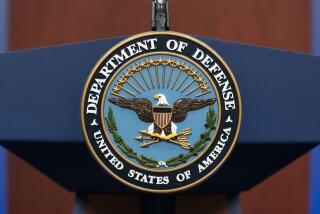Navy May Send Ships to Fight Colombia Drugs
- Share via
WASHINGTON — The Navy, in a move intended to escalate U.S. military pressure on Colombian drug traffickers, has proposed deploying a flotilla of warships to the Colombian coast beginning early next year, Bush Administration officials said Wednesday.
From their floating position in international waters of the Caribbean off Colombia, the ships would provide a base for troops and aircraft to intercept airborne and seaborne drug traffickers, the officials said.
Under a proposal presented to Defense Secretary Dick Cheney late last week and to representatives from federal drug-fighting agencies Tuesday, the Navy would operate an aircraft carrier battle group or a marine amphibious task force at all times off Colombia.
Although Cheney has not formally approved the proposal, several senior Administration officials said the move is certain to win his favor.
“There are no showstoppers,” one senior Pentagon official said. Reaction by Cheney and other Administration leaders of the drug interdiction effort, he said, was “pretty positive.”
“It’s a done deal,” said a knowledgeable Administration official.
“There’s going to be a dramatic increase in the Navy ship presence in the Caribbean starting next year, including a carrier battle group,” another senior Pentagon official said. “This is going to greatly increase the United States’ ability to monitor and interdict drug traffic in that area.”
However, other officials said the proposal represents a Navy effort to enlist in the drug war at the lowest possible additional cost.
The deployments would last one to two months--far shorter than the carriers’ normal deployments of six months. The ships selected to operate off Colombia would be drawn from among those scheduled to conduct one- and two-month training deployments anyway.
The Atlantic Command’s seven aircraft carriers and two 39,300-ton amphibious assault ships would form the core of the naval force operating off Colombia, officials said. To maintain a steady presence there, the Navy would use an amphibious task force--a four-ship force augmented by frigate and destroyer escorts--to relieve carrier battle groups that have finished their Caribbean deployment.
Until now, those “work-up” deployments have been conducted nearer to the ships’ home ports of Norfolk, Va., and Mayport, Fla. By moving the ships further offshore for their training, the Navy would spend more money for fuel but would not press into service crews and ships that otherwise would be at rest.
In addition, Navy officials said such a move would offer their crews more realistic training situations.
The proposal for a fleet of warships off Colombia came from the Norfolk-based Atlantic Command, which oversees all naval forces operating in the Caribbean, the Atlantic and the Mediterranean.
The move is part of a range of military drug-fighting initiatives called for by Cheney earlier this year. Already, Cheney has approved formation of a drug-fighting task force based at Ft. Bliss, Tex., called JTF-6.
Proposed by the U.S. Forces Command, which oversees all Army forces based in the United States, the new unit helps inspect cargo, run reconnaissance operations and ferry drug enforcement agents on raids along the U.S.-Mexican border.
The proposed naval flotilla off Colombia is designed to bolster the efforts of the besieged government in Bogota to reduce the flow of drug-processing chemicals into Colombia and street-ready drugs out of the country. The Colombian navy, whose four frigates and 19 coastal patrol boats are stretched across the nation’s Caribbean and Pacific coasts, has had little success in stemming the flow.
Still unclear, said officials, is whether the aircraft operating off the aircraft carriers and amphibious ships would be permitted to chase drug traffickers back into Colombian airspace.
If used for the Colombian mission, amphibious ships called LHAs would carry as many as a dozen Harrier jump jets, which can operate off the ships’ 118-foot flight deck. The amphibious ships would also carry a smaller-then-usual complement of as few as 30 Marines. They would be supplemented by a Coast Guard detachment whose job would be to board ships in search of drugs and drug-processing chemicals.
Pentagon officials, responding to concerns that Caribbean nations are believed certain to raise, were at pains to note that the amphibious ships would not be used in their traditional role--as staging bases for massive amphibious assaults.
Times staff writer Ronald J. Ostrow contributed to this story.
More to Read
Sign up for Essential California
The most important California stories and recommendations in your inbox every morning.
You may occasionally receive promotional content from the Los Angeles Times.














